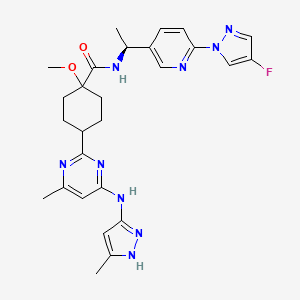Drug Information
Drug (ID: DG01307) and It's Reported Resistant Information
| Name |
Pralsetinib
|
||||
|---|---|---|---|---|---|
| Synonyms |
Pralsetinib; BLU-667; 2097132-94-8; Pralsetinib free base; cis-Pralsetinib; Blu667; trans-Pralsetinib; UNII-1WPE73O1WV; 1WPE73O1WV; BLU123244; 2097132-94-8 (free base); 2097132-93-7; N-[(1S)-1-[6-(4-fluoropyrazol-1-yl)pyridin-3-yl]ethyl]-1-methoxy-4-[4-methyl-6-[(5-methyl-1H-pyrazol-3-yl)amino]pyrimidin-2-yl]cyclohexane-1-carboxamide; X581238; cis-N-{(1S)-1-[6-(4-fluoro-1H-pyrazol-1-yl)pyridin-3-yl]ethyl}-1-methoxy-4-{4-methyl-6-[(5-methyl-1H-pyrazol-3-yl)amino]pyrimidin-2-yl}cyclohexane-1-carboxamide; Gavreto; Cyclohexanecarboxamide, N-((1S)-1-(6-(4-fluoro-1H-pyrazol-1-yl)-3-pyridinyl)ethyl)-1-methoxy-4-(4-methyl-6-((5-methyl-1H-pyrazol-3-yl)amino)-2-pyrimidinyl)-, cis-; cyclohexanecarboxamide, N-[(1S)-1-[6-(4-fluoro-1H-pyrazol-1-yl)-3-pyridinyl]ethyl]-1-methoxy-4-[4-methyl-6-[(5-methyl-1H-pyrazol-3-yl)amino]-2-pyrimidinyl]-, cis-; Q4J; Pralsetinib [INN]; Pralsetinib [USAN]; Blu667Blu667; cis-BLU-667; Pralsetinib (USAN/INN); BLU-667 (Pralsetinib); CHEMBL4582651; SCHEMBL18789228; SCHEMBL18789229; SCHEMBL18806610; GTPL10033; BDBM435009; BDBM435010; AMY16875; EX-A1944; EX-A3347; NSC811429; s8716; US10584114, Compound 129; US10584114, Compound 130; WHO 11004; AKOS037648884; BLU-123244; HY-112301A; NSC-811429; BS-15942; HY-112301; CS-0043448; CS-0044766; D11712; X-581238; (cis)-N-((S)-1-(6-(4-Fluoro-1H-pyrazol-1-yl)pyridin-3-yl)ethyl)-1-methoxy-4-(4-methyl-6-(5-methyl-1H-pyrazol-3-ylamino)pyrimidin-2-yl)cyclohexanecarboxamide; BLU-667; trans-N-{(1S)-1-[6-(4-fluoro-1H-pyrazol-1-yl)pyridin-3-yl]ethyl}-1-methoxy-4-{4-methyl-6-[(5-methyl-1H-pyrazol-3-yl)amino]pyrimidin-2-yl}cyclohexane-1-carboxamide; trans-N-{(1S)-1-[6-(4-fluoro-1H-pyrazol-1-yl)pyridin-3-yl]ethyl}-1-methoxy-4-{4-methyl-6-[(5-methyl-1H-pyrazol-3-yl)amino]pyrimidin-2-yl}cyclohexane-1-carboxamide
Click to Show/Hide
|
||||
| Indication |
In total 2 Indication(s)
|
||||
| Structure |

|
||||
| Drug Resistance Disease(s) |
Disease(s) with Clinically Reported Resistance for This Drug
(2 diseases)
[1]
[1]
|
||||
| Target | Proto-oncogene c-Ret (RET) | RET_HUMAN | [1] | ||
| Click to Show/Hide the Molecular Information and External Link(s) of This Drug | |||||
| Formula |
C27H32FN9O2
|
||||
| IsoSMILES |
CC1=CC(=NN1)NC2=NC(=NC(=C2)C)C3CCC(CC3)(C(=O)N[C@@H](C)C4=CN=C(C=C4)N5C=C(C=N5)F)OC
|
||||
| InChI |
1S/C27H32FN9O2/c1-16-11-22(33-23-12-17(2)35-36-23)34-25(31-16)19-7-9-27(39-4,10-8-19)26(38)32-18(3)20-5-6-24(29-13-20)37-15-21(28)14-30-37/h5-6,11-15,18-19H,7-10H2,1-4H3,(H,32,38)(H2,31,33,34,35,36)/t18-,19 ,27 /m0/s1
|
||||
| InChIKey |
GBLBJPZSROAGMF-SIYOEGHHSA-N
|
||||
| PubChem CID | |||||
| TTD Drug ID | |||||
Type(s) of Resistant Mechanism of This Drug
Drug Resistance Data Categorized by Their Corresponding Diseases
ICD-02: Benign/in-situ/malignant neoplasm
| Drug Resistance Data Categorized by Their Corresponding Mechanisms | ||||
|
|
||||
| Key Molecule: Proto-oncogene tyrosine-protein kinase receptor Ret (RET) | [1] | |||
| Molecule Alteration | Mutation | . |
||
| Resistant Disease | Non-small cell lung cancer [ICD-11: 2C25.Y] | |||
| Experimental Note | Identified from the Human Clinical Data | |||
| Experiment for Drug Resistance |
Cell-free DNAs (cfDNAs) analysis | |||
| Mechanism Description | Selpercatinib (LOXO-292) and pralsetinib (BLU-667) are highly potent RET-selective protein tyrosine kinase inhibitors (TKIs) for treating advanced RET-altered thyroid cancers and non-small-cell lung cancer (NSCLC). RET mutations at the solvent front and the hinge are resistant to both drugs. Selpercatinib and pralsetinib use an unconventional mode to bind RET that avoids the interference from gatekeeper mutations but is vulnerable to non-gatekeeper mutations. | |||
| Drug Resistance Data Categorized by Their Corresponding Mechanisms | ||||
|
|
||||
| Key Molecule: Proto-oncogene tyrosine-protein kinase receptor Ret (RET) | [1] | |||
| Molecule Alteration | Mutation | . |
||
| Resistant Disease | Advanced RET-altered thyroid cancer [ICD-11: 2D10.Y] | |||
| Experimental Note | Identified from the Human Clinical Data | |||
| Experiment for Drug Resistance |
Cell-free DNAs (cfDNAs) analysis | |||
| Mechanism Description | Selpercatinib (LOXO-292) and pralsetinib (BLU-667) are highly potent RET-selective protein tyrosine kinase inhibitors (TKIs) for treating advanced RET-altered thyroid cancers and non-small-cell lung cancer (NSCLC). RET mutations at the solvent front and the hinge are resistant to both drugs. Selpercatinib and pralsetinib use an unconventional mode to bind RET that avoids the interference from gatekeeper mutations but is vulnerable to non-gatekeeper mutations. | |||
| Drug Sensitivity Data Categorized by Their Corresponding Mechanisms | ||||
|
|
||||
| Key Molecule: Proto-oncogene tyrosine-protein kinase receptor Ret (RET) | [2] | |||
| Molecule Alteration | Missense mutation | p.C634W (c.1902C>G) |
||
| Sensitive Disease | Thyroid gland cancer [ICD-11: 2D10.0] | |||
| Experimental Note | Identified from the Human Clinical Data | |||
| In Vitro Model | TPC-1 cells | Thyroid | Homo sapiens (Human) | CVCL_6298 |
| Ba/F3 cells | Colon | Homo sapiens (Human) | CVCL_0161 | |
| TT cells | Thyroid gland | Homo sapiens (Human) | CVCL_1774 | |
| MZ-CRC-1 cells | Pleural effusion | Homo sapiens (Human) | CVCL_A656 | |
| LC2/ad cells | Pleural effusion | Homo sapiens (Human) | CVCL_1373 | |
| In Vivo Model | BALB/c nude mouse PDX model | Mus musculus | ||
| Experiment for Molecule Alteration |
Western blotting analysis | |||
| Experiment for Drug Resistance |
Promega assay | |||
| Key Molecule: Proto-oncogene tyrosine-protein kinase receptor Ret (RET) | [2] | |||
| Molecule Alteration | Missense mutation | p.M918T (c.2753T>C) |
||
| Sensitive Disease | Thyroid gland cancer [ICD-11: 2D10.0] | |||
| Experimental Note | Identified from the Human Clinical Data | |||
| In Vitro Model | TPC-1 cells | Thyroid | Homo sapiens (Human) | CVCL_6298 |
| Ba/F3 cells | Colon | Homo sapiens (Human) | CVCL_0161 | |
| TT cells | Thyroid gland | Homo sapiens (Human) | CVCL_1774 | |
| MZ-CRC-1 cells | Pleural effusion | Homo sapiens (Human) | CVCL_A656 | |
| LC2/ad cells | Pleural effusion | Homo sapiens (Human) | CVCL_1373 | |
| In Vivo Model | BALB/c nude mouse PDX model | Mus musculus | ||
| Experiment for Molecule Alteration |
Western blotting analysis | |||
| Experiment for Drug Resistance |
Promega assay | |||
References
If you find any error in data or bug in web service, please kindly report it to Dr. Sun and Dr. Zhang.
